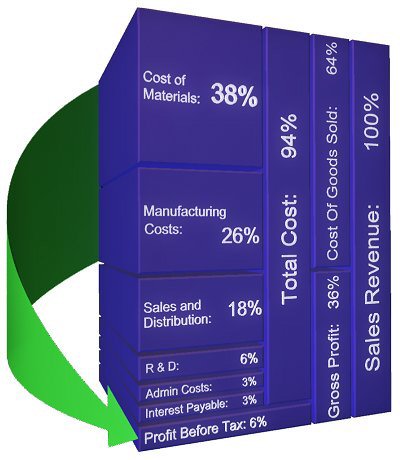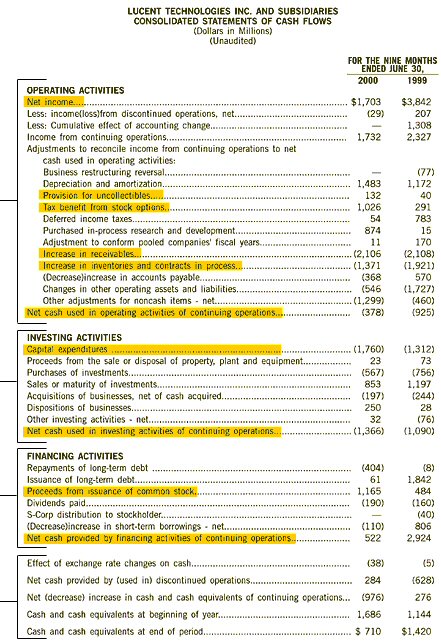8.01 - Financial Accounting
If you are an engineer this is probably the last place you have looked. However, for an engineer it is very important to understand the business impact of his decisions. There are three important documents from which we can illustrate the key role of engineers in business. Let’s look at the first of those documents – the Profit and Loss (P&L) account. The P & L account is the external historical report of how a company has performed with the investors funds. The typical P&L account looks like this.
The last item on the left is the very small margin of profit – in this case 6%. But notice the cost factors directly affected by engineering design:-
- The Cost of Materials
- Manufacturing Costs
- Research & Development Costs

The Cost of Materials
The complexity of products and the number of parts and the amount of raw material are directly specified by the design engineer. These decisions are generally the exclusive domain of the design engineer and only s/he can decide what is needed or not needed to meet a certain functional requirement.
Manufacturing Costs
The cost of manufacturing is largely influenced by an engineer’s decisions. Directly or indirectly the manufacturing costs are dictated by his or her design decisions. Once the design is frozen there is very little a manufacturing engineer can do to alter those core costs.
Research and Development Costs
The way the design engineers go about their profession also affects company costs. The cost of R&D shown on the chart is fairly typical of a manufacturing company. Very often the amounts spent on R&D are not disclosed directly and are to be found in the notes to the accounts. The efficiency of design highlights the value that is being given. Some design groups spend many hours wasting investor’s funds, “re-inventing the wheel,” because they cannot find work done, or parts designed in the past. Another factor is not using the appropriate methods and technology to rapidly and efficiently develop new products. Therefore design management and product design efficiency has a huge impact on the cost of materials and manufacturing costs.
The Balance Sheet
Fixed Assets |
£ |
£ |
Ordinary Funds |
£ |
£ |
Intangibles |
0 |
|
Issued Capital |
80 |
|
Fixed Assets |
440 |
|
Capital Reserves |
60 |
|
Investments |
40 |
|
Revenue Reserves |
220 |
|
| |
|
480 |
|
|
360 |
Current Assets |
|
|
Long Term Loans |
|
|
Inventory |
120 |
|
|
|
200 |
Accounts Receivable |
160 |
|
Current Liabilities |
|
|
Cash |
20 |
|
Short Loans |
60 |
|
Miscellaneous |
12 |
|
Accounts Payable |
140 |
|
| |
|
|
Miscellaneous |
40 |
|
| |
|
320 |
|
|
240 |
| |
|
800 |
|
|
800 |
Engineers are not too concerned over balance sheet items, unless s/he is also a share holder. The engineer, like investors or shareholders, can get some insight into the efficiency of manufacturing and logistics by looking at the inventory levels and fixed assets and using it to compare information in the third document – the Cash Flow Statement.
The Cash Flow Statement
The cash flow statement (CFS) shows the movement of cash or cash equivalents both within and outside the company for a given period. It is an indicator of the firm’s ability to generate cash to provide funds to pay dividends or invest in capital equipment. The cash flow statement is divided into the following areas - operating activities, investing and financing activities.

Operating Activities
Operating activities are the principal money generating activities for firms not primarily involved in investments and financial operations. In manufacturing it is the prime determinate for a company’s profits or losses.
Investing Activities
Investing Activities are the acquisition and disposal of long term assets not regarded as cash or cash equivalents.
Financing Activities
These result from the borrowing and equity needs of the organization.
Foreign currency cash flows
This requires the reporting of foreign currency cash flow costs incurred at the rate of exchange at the time of the transaction is made.
Cash and cash equivalents
This is where the company is required to disclose and reconcile the cash flows with the equivalent entries on the balance sheet. It is also required that significant cash and cash equivalents not available for immediate use are disclosed here with reasons for their non-availability.
Accounts usefulness to the designer and engineer for decision making and project selection
Engineers, with assistance from accounting, can ensure that any product design improvements and design process improvements are worthwhile by subjecting them to appropriate rigorous financial appraisal throughout the design and development process.
The use of classification, modular design and design for manufacturing are big contributors to manufacturing profitability and should be examined with all possible vigour and seriousness for their impact on the efficiency of manufacturing operations.
For instance, part classification and group technology can lead to a 1% drop in material costs with perhaps slightly smaller impacts on manufacturing costs involving the streamlining of operations and purchasing efficiencies. If the material cost savings alone were transferred to company profit before tax that represents a 16% increase in profits.
The effect on the balance sheet could be reduced inventory. That in turn makes cash available for other purposes and generally improves cash flow in the organization.
The net result is that the company becomes more attractive to investors and can lead to new or more exciting fields of endeavour in the design and engineering field.
Notes:-
Generally, most businesses adopt a conservative (pessimistic) approach to financial reporting which is required by the financial accounting legislations of various countries. Occasionally, at the behest of strong charismatic business leaders, they get involved in the somewhat euphoric practice of reporting optimistically (creative accounting). It seems to happen in cycles. Once started, it is difficult to stop until the firms go bust.
A little reading on “the south sea bubble”, “dotcom” and “ENRON” provides some useful and cautious lessons for would-be investors who rely solely on financial statements and annual reports.